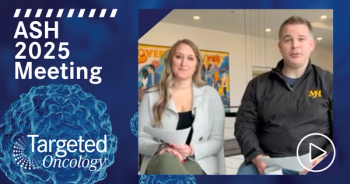
Determining the Risk Associated With Mutations Identified From Multigene Testing
Figuring out how a certain genetic result found through multigene testing might change not only the type of intervention but its timing is the chief challenge, according to Mark Robson, MD, in a presentation at the 2017 Lynn Sage Breast Cancer Symposium.
Mark Robson, MD
Figuring out how a certain genetic result found through multigene testing might change not only the type of intervention but its timing is the chief challenge, according to Mark Robson, MD.
Multigene panel testing offers the ability to identify genetic mutations in patients with greater detail; while this is beneficial for the treatment of patients with breast cancer, he says, it also comes with challenges as the results can be difficult to understand at times, with many mutations of unknown significance unearthed in the process of the testing.
"We're all good withBRCA 1and2, but these new ones are challenging," said Robson, clinic director of the clinical genetics service at Memorial Sloan Kettering Cancer Center (MSK), in a presentation during the 2017 Lynn Sage Breast Cancer Symposium, which was sponsored by Northwestern University's Robert H. Lurie Comprehensive Cancer Center.
Robson recommended using available data to put each patient on an "age-specific spectrum of risk," adjusting the timing of interventions to match the patient's risk of disease relative to the general population. For example, if a woman in the general population should start screening mammograms at age 40, a woman carrying thePALB2gene variant has the same level of disease risk at age 30, and should start having screenings earlier.
Robson's presentation covered 9 genes associated with moderate cancer risk (with relative risk levels between 2 and 5):CHEK2,ATM,PALB2,BRIP1,RAD51C,RAD51D,BARD1,NBN, and the Lynch genes. A review of available studies has revealed a mixed picture. For example,CHEK2overall is associated with about the same level of risk, 2.3 to 2.4, as having 1 first-degree relative with breast cancer. However, someCHEK2mutations carry very little risk.
These are far from the only possibilities, of course. Tests are available for dozens of gene variants that may make some contribution to breast cancer risk, either alone or in combination with other genes or risk factors. Some represent a low risk of breast cancer but elevated risk for ovarian canceror vice versa. Some don't represent any increased risk until the patient hits a certain age, and then the risk may spike to moderate or high.
Robson said clinicians must answer 2 questions as they expand the use of multigene panels in their practices. First, are the results "actionable": is the association large enough and robust enough to change a treatment recommendation? And second, do they have "clinical utility": that is, if the test is used to direct care, do patients have better outcomes? It's too early to answer the second question with large-scale studies, but Robson said some consensus is beginning to build around the first for some gene variants.
It is likely that a number of patients have these moderate risk gene variants, if testing is completed. Reviews of commercial lab data on almost 80,000 breast cancer patients showed that several genes associated with breast cancer risk have a prevalence that's comparable toBRCA 1and2. The most common,CHEK2, showed a prevalence of 1.28%, and the prevalence ofATMandPALB2approached 1%.
Robson noted that genome sequencing is still too expensive to justify a large-scale controlled study that would reliably measure prevalence in populations that don't have breast cancer, but some studies are using data from public databases like the Exome Aggregation Consortium, a broad sample of genomic data acquired for other studies, as a reasonable proxy.
"The more we do, the more complicated it gets, unfortunately," Robson said, because gene variations can have several different versions, and some mutations have a much larger effect than others.
Patients given multigene panel tests at MSK are usually referred by their physicians because of a disease diagnosis or a strong family history, though there is no standardized path and some patients self-refer, Robson said. With the increasing availability of genome sequencing and other gene assays, more patients are likely to acquire information about cancer risk genes as a result of seeking testing on their own, or being tested for something else.
Regardless of how they learn about it, what should clinicians tell a 25-year-old patient who's facing elevated risk a decade or two from now? He suggesting the following example: "We understand more about your lifetime risk, and we know that when you're 40, we need to start doing something different."








































